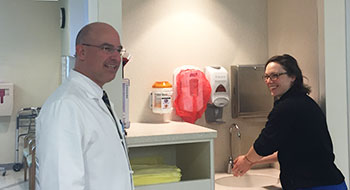A gentle touch can help improve hand hygiene

Bridget Nuara, RN, MICU safety coach, and Richard Martinello, MD, Infection Prevention sponsor, Hand Hygiene Performance Improvement Team, discuss hand hygiene for patients on contact precautions.
When it comes to hand hygiene, a little reminder from a co-worker can go a long way.
One issue monitors and others have identified hospital-wide is hand hygiene and glove use. Some important reminders:
- Gloves must be worn for all patients on contact precautions and, per standard precautions, when in contact with non-intact skin or body fluids.
- Everyone must perform hand hygiene before donning and after removing gloves.
- Gloves should not be washed, or worn for multiple patients
That’s why the HRO safety behavior Mentor Each Other - 200% Accountability has taken center stage in Yale New Haven Hospital’s hand hygiene improvement efforts.
Bridget Nuara, RN, HRO safety coach, Medical Intensive Care Unit (NP 9-10), recently demonstrated 200% accountability when she “stopped the line” after seeing a resident leave the room of a patient who had Clostridium difficile. The resident used Purell instead of soap and water and was preparing to enter another patient room. Nuara provided feedback that washing with soap and water was required to help prevent infection transmission. She followed up by saying, “I hope you would do the same for me so we can keep patients and staff safe.”
This kind of gentle touch in requesting a correction and the acceptance of a “cross check” between staff illustrates the kind of safety culture YNHH’s Hand Hygiene Performance Improvement Team is promoting.
Victor Morris, MD, associate chief medical officer, and Jeannette Bronsord, RN, director of nursing, Surgical Services, are sponsors of the team, which is helping each inpatient unit and ambulatory setting reach hand hygiene compliance targets – a threshold goal of 80 percent and a maximum goal of 90 percent.
“Practicing good hand hygiene is one of the simplest, yet most effective ways to prevent hospital-acquired infections,” Bronsord said. “These infections can be serious – sometimes fatal – to our patients, and they can spread to physicians and staff.”
In addition to the use of CHAMP safety behaviors, the hospital’s ongoing hand hygiene improvement efforts include physician and staff education, emphasis on hand hygiene during leadership rounding and anonymous hand hygiene monitors on inpatient units who document how often staff members from all disciplines clean their hands. Selected ambulatory sites will begin monitoring hand hygiene compliance using patient survey cards this month. Data collected are broken down by service line, unit, shift and employee role and tracked monthly to identify low-performing areas and guide improvements.
For more information, visit the YNHH Infection Control Manual-Standard Precautions (on the clinical work station or hospital intranet) or the World Health Organization site,
www.who.org.
